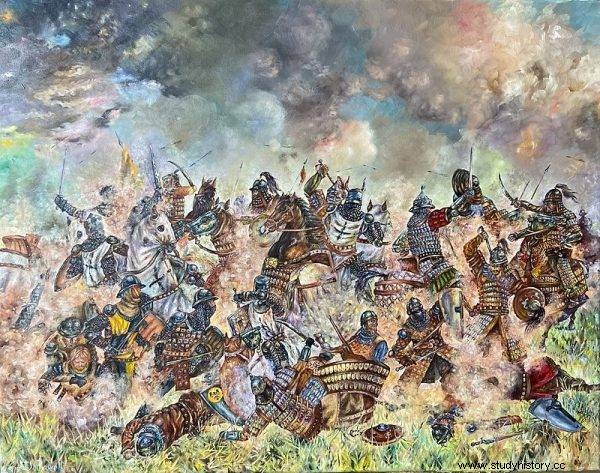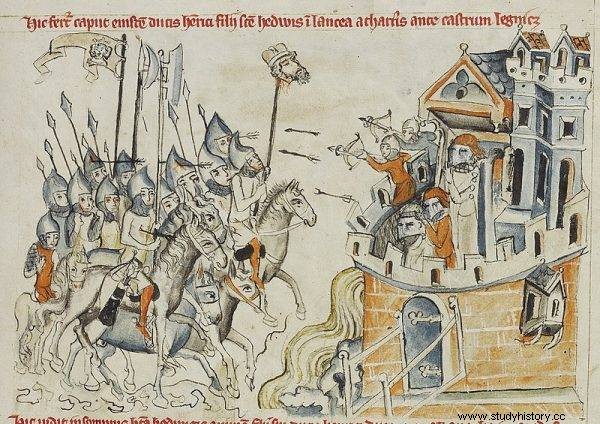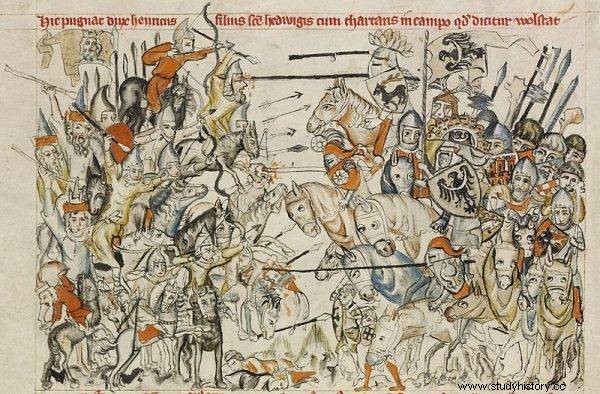Despite the initial advantage of the Polish cavalry, this battle ended in failure. Prince Henry II the Pious was captured and executed, and his head was impaled on a spear ...
The Battle of Legnica, fought on April 9, 1241, is one of the most famous battles of the Polish army in the Middle Ages. The knights from Lower and Upper Silesia, and probably from Greater Poland, faced the Mongols who had previously managed to capture Ruthenia and set off for Poland.
After the seizure of Rus, the next goal of the brave people from the east became well-developed, rich Hungary. The attack on the Polish state was most likely just a sort of preventive action - The Tatars wanted to stop Poles from possibly helping Hungarians.
The numbers don't lie?
The battle raises a lot of controversy among historians. A contentious issue is, among other things, the number of troops on both sides. Some sources say that the Mongols had up to 10,000 warriors ("only" 8,000 were supposed to reach Lower Silesia) , and the commander of the Polish side, Prince Henry II the Pious, was to have about 6,000 of his own knights and 2,000 German-Moravian soldiers under his command.
Today, however, it is considered that these numbers were definitely overstated - scholars believe that the Polish prince could mobilize 1,000-2,000 people (the names of so many Silesian knights can be found in various sources dated to the mid-thirteenth century). In the most optimistic variant, his army near Legnica numbered 4,000 armed men.

Today, however, it is considered that these numbers were definitely overstated - scholars believe that the Polish prince could mobilize 1,000-2,000 people (photo:Janelle Powell Art / CC BY-SA 4.0)
The backbone of the army were Silesians, although according to Długosz they were also supported by the knights of Greater Poland and Lesser Poland. Also on the Mongolian side, the figures were overestimated - the Tatar army consisted of a maximum of 6,000–7,000 warriors. Most likely, they were accompanied by small troops of mercenaries from nomadic tribes, which the Mongols had previously subjugated to themselves in eastern Europe.
A tragedy of mistakes
Apart from the flowery, but not entirely truthful, description of Długosz, only short, not very detailed references have survived, therefore little is known about the course of the battle. Henry II's heavy cavalry in the early stages of the fight could have gained an advantage especially since the Mongols were exhausted from the long march and numerous skirmishes along the way.
According to C. de Bridia - a historian unidentified by historians, who lived in the mid-thirteenth century and wrote down its course shortly after the battle in Legnica - at some point the Tatars wanted to leave the battlefield and retreated. However, it was also a critical moment for the Polish army.
The knights, then still having the upper hand, panicked and ... also began to flee under the leadership of the Duke of Opole and Racibórz, Mieszko II the Obese. Then the Mongol commander detained his soldiers and ordered them to attack immediately.

Henry II's heavily armed cavalry in the early stages of the fight could have gained an advantage, especially since the Mongols were exhausted from the long march and numerous skirmishes along the way.
The invaders managed to capture Henry II the Pious and break up his troops. The defenders of Christianity were thus defeated and their prince was beheaded. The barbarians from the east would then impose his head on a spear and show them to the surviving knights. In this way, they completely destroyed the already low morale of Poles.
Confident that the broken army would no longer be a threat to their plans to conquer Hungary, the Mongols returned to the east to support Batu Khan's main force. According to the thirteenth century historian, they took the head of a defeated prince with them to throw it on a pile of Christian corpses piled up at the feet of their ruler.
Read also:The Battle of Orsza 1514 - "The collision of the Moscow Middle Ages with the Jagiellonian Renaissance"
Landscape after battle
The Battle of Legnica had far-reaching consequences for Lower Silesia and the entire Polish state. The knights of Henry II lost, but in a sense Western Christianity was defended (as the Mongols withdrew from the German-Czech border).
Unfortunately, hopes for a quick reunification of the country broken up into districts have fallen. The state that the Silesian Henryków had been building for decades fell apart with the death of the last ruler - the Pious . For several dozen years, Poland once again plunged into chaos, compounded by numerous internal conflicts and fratricidal wars. After the death of Henry II the Pious, his son, Bolesław II Rogatka, then about twenty years old, took over the power.
The discussion between German and Polish historians about the significance of the Mongol invasion of 1241 began as early as the 19th century. Its main point was the question of whether the Tatars actually enabled the German colonization of Silesia - after their march through Poland, the western principalities were devastated, primarily in terms of demographics. Thanks to this, in the following centuries, Germans could replace the people of Polish origin.

The Battle of Legnica had far-reaching consequences for Lower Silesia and the entire Polish state (photo:public domain)
German historians supported this hypothesis, pointing out that the year 1241 was a breakthrough date for the development of the German colonization action and the subsequent domination of German culture in Silesia.
Polish researchers are of a different opinion. In their opinion, the Mongol invasion did not leave such large losses in the population, therefore we cannot speak of a wave of immigrants in Germany that was to appear at the time. They also draw attention to the fact that colonization actions were undertaken several times, in different periods, and the actual domination of the native culture took place only after the Germans took power in this area.
This does not mean, however, that the defensive battle of Legnica is considered only an insignificant skirmish. The defeat of the Poles against the Mongols became a lesson for the Polish knighthood. In later centuries, the heavy cavalry of the Commonwealth became one of the best military formations in Europe (of course, we are talking about hussars). The defenders from the Legnica Field were also commemorated at the Tomb of the Unknown Soldier in Warsaw - one of the plaques bears the inscription "LEGNICA, 9 April 1241".
Read also:Lithuanian conflagration - or about the greatest enemy of medieval Poland
A sea of questions
Jan Długosz created a very detailed description of the clash in 1241, in which he characterized the Polish forces (according to him, they were to be divided into 4 troops joining the fight in turn). For a long time his account was considered credible, but at the end of the 19th century, Aleksander Semkowicz, a professor of the University of Lviv dealing with medieval studies, presented a list of reservations and inaccuracies in the version of a medieval chronicler. They concerned over-coloring descriptions, changing details and falsifying the facts.
The unresolved question was why Henry II decided to fight only in April, when the Mongolian army led by Paidar had already passed through Lesser Poland and a large part of Silesia along the way spreading death and destruction, leaving behind the ruins of deserted villages and cities.
After all, the pious was the strongest prince in divided Poland. Even he, however, did not want to risk a premature clash with the mighty army from the east. Most likely, he hoped that the long march would thin the Tatar troops a bit. Moreover, he expected support from Christian countries.
Interestingly, there was also a hypothesis that the battle did not take place near Legnica (in Legnickie Pole), but near Oława - in the town of Legnic. This thesis is supported by the fact that no remains of the battle (e.g. parts of weapons) have been found at the traditionally recognized battlefield. On the other hand, it is possible that the local peasants looted the corpses after the battle and collected all the metal elements.
